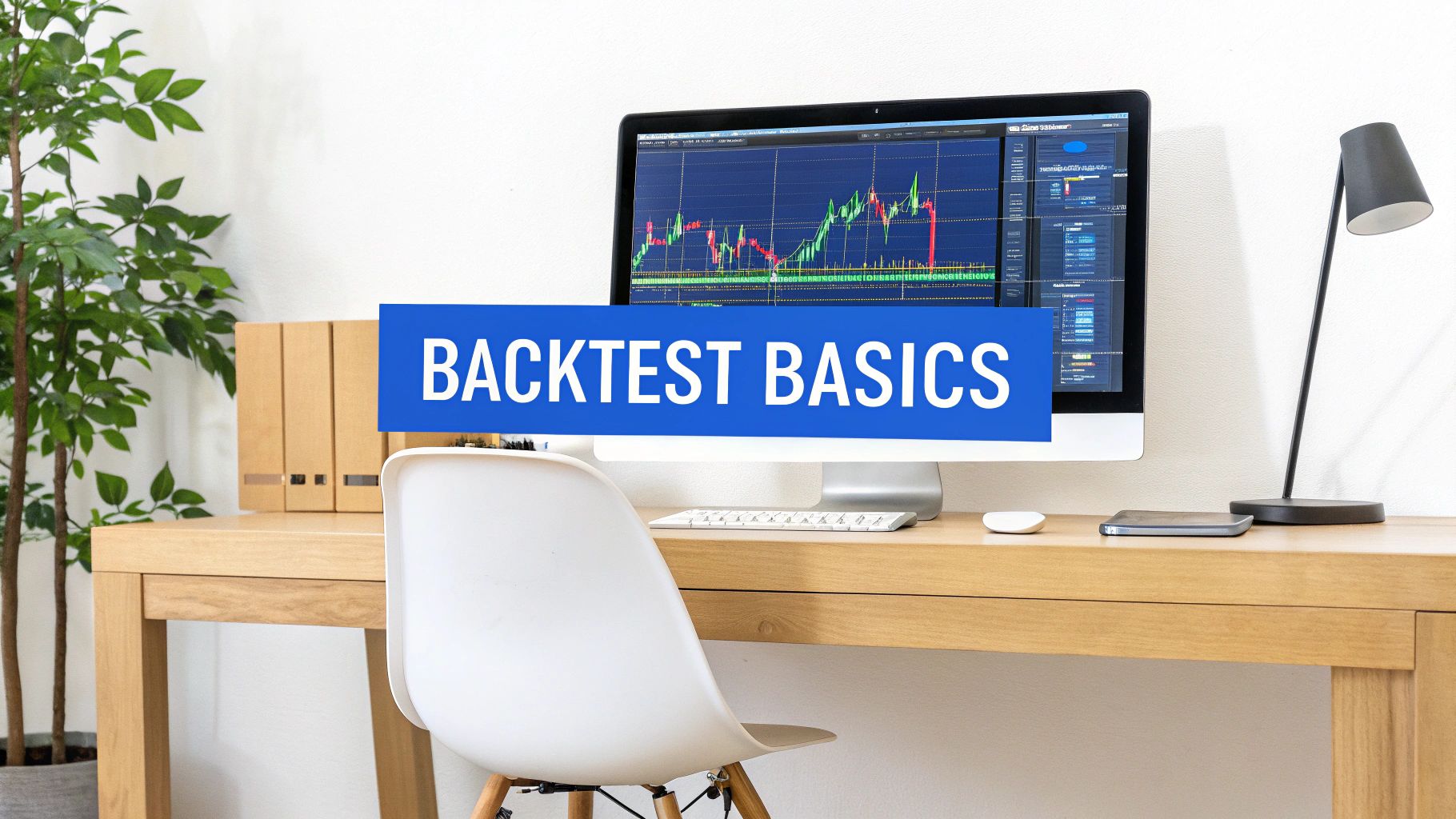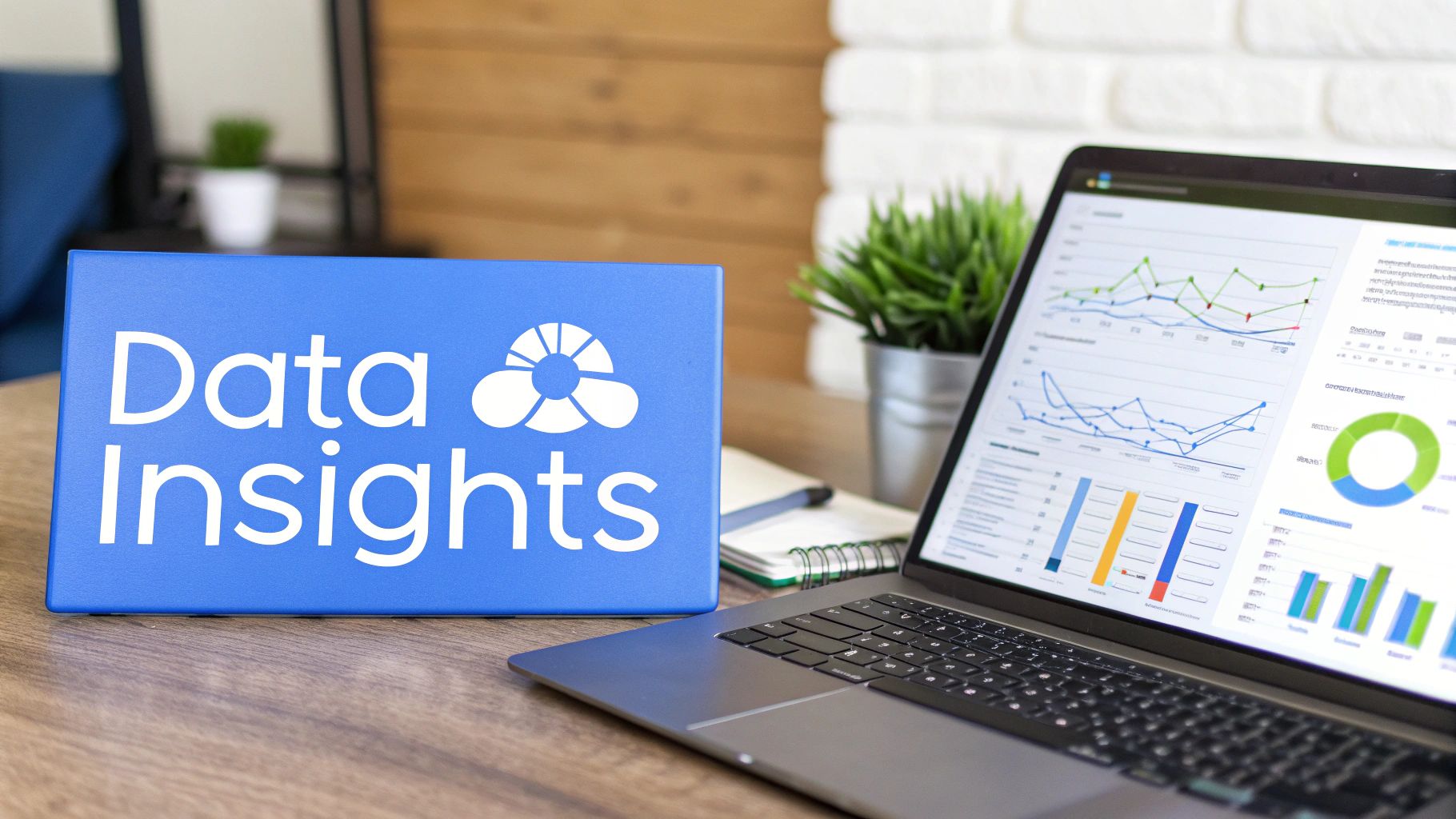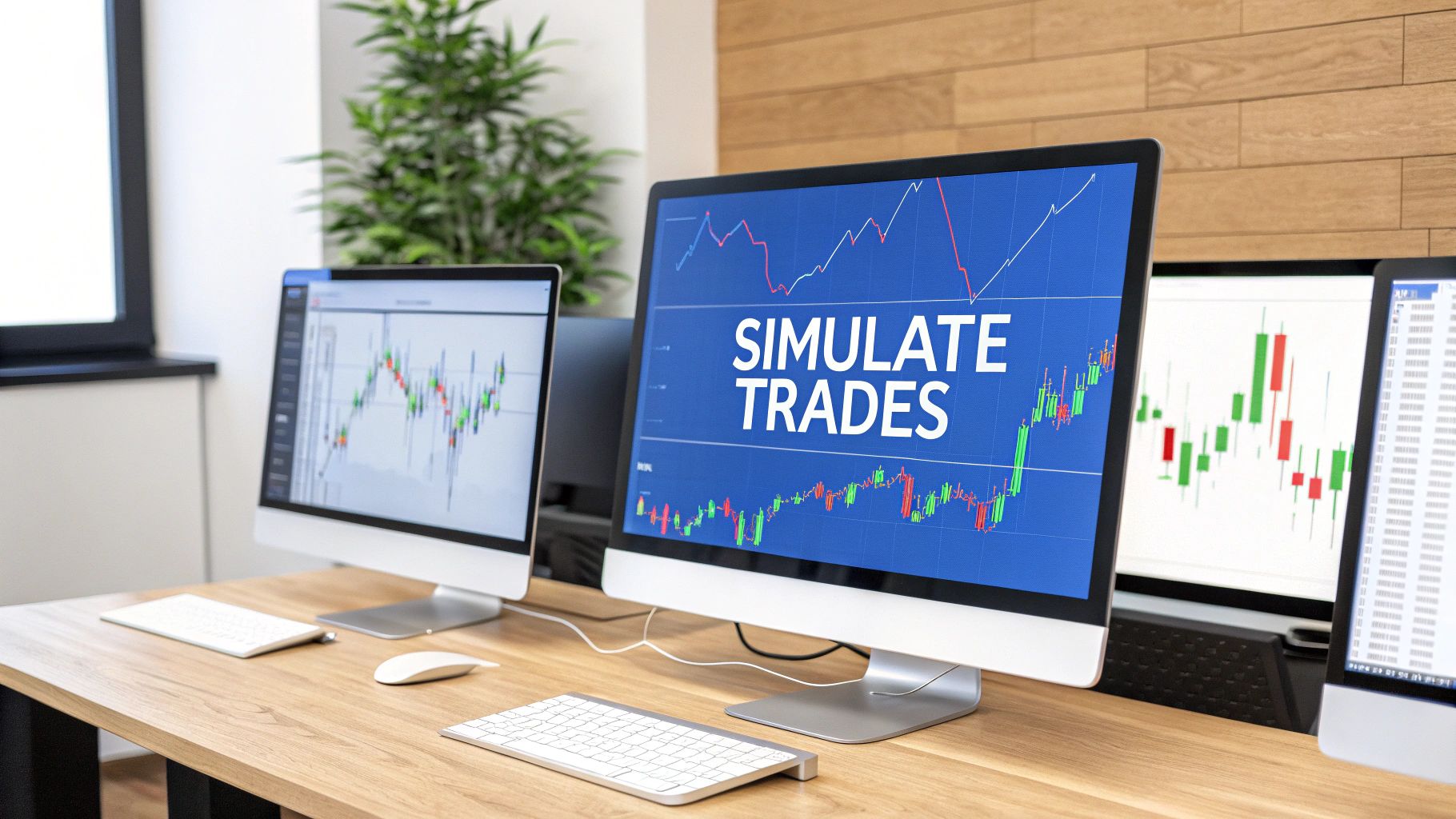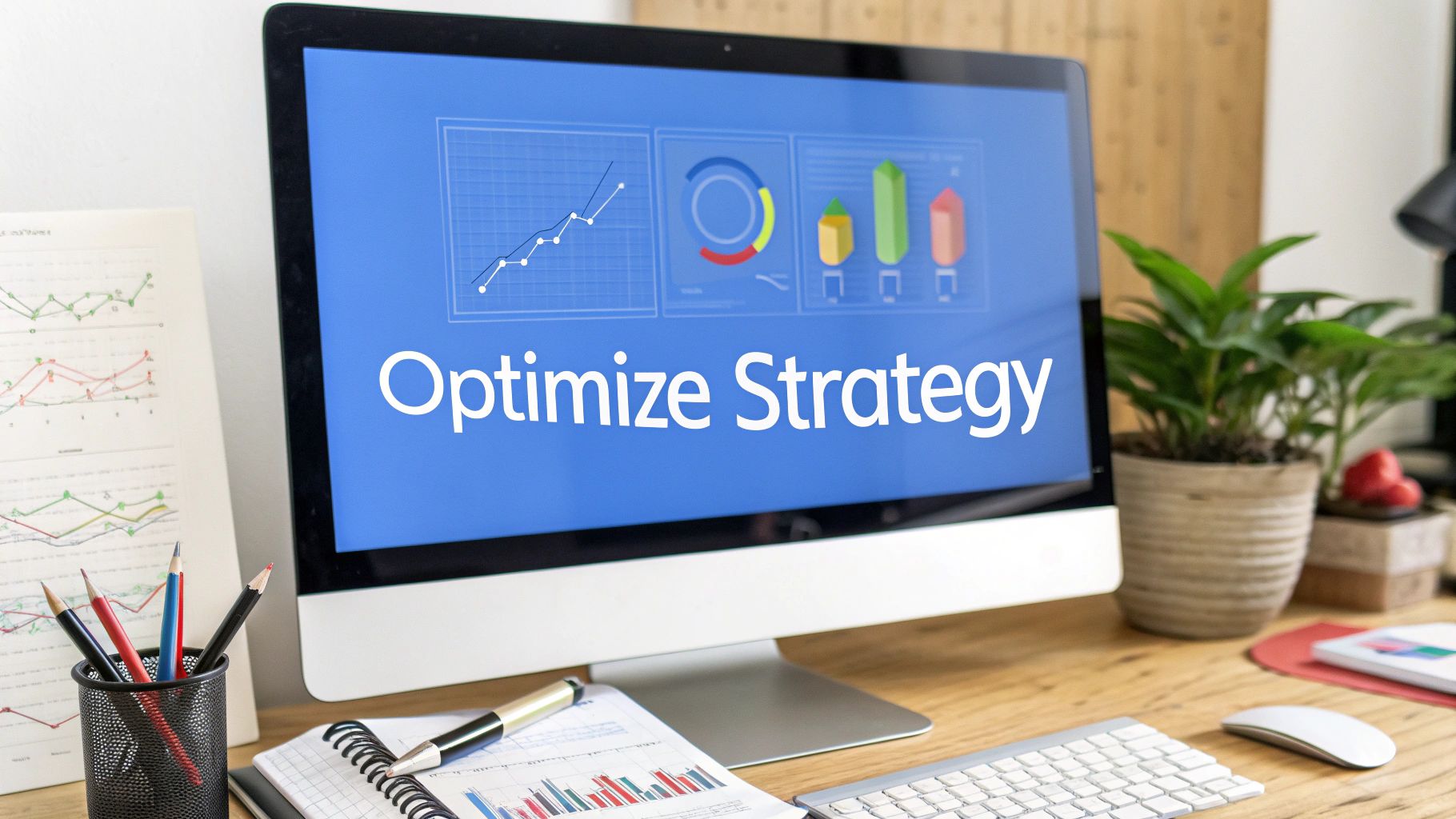How to Backtest Trading Strategy: Essential Tips
Mastering Backtesting Fundamentals

Imagine perfecting your golf swing without ever hitting a ball. Trading without backtesting is similar. Backtesting lets you refine your trading strategies using historical market data. It provides a risk-free environment to experiment and identify potential flaws.
This process is essential for any trader seeking to optimize their approach and boost their chances of success. Backtesting simulates trades and analyzes the outcomes, building confidence before risking real capital.
Why Backtesting Is Essential
Backtesting isn't just a tool; it's a cornerstone of successful trading. It offers an objective assessment of a strategy's viability. By applying your rules to past market data, you gain valuable insights into potential performance.
This understanding helps identify areas for improvement and increases the likelihood of future profits. Backtesting also reveals the risks associated with a strategy, enabling better risk management.
Key Components of Backtesting
Effective backtesting requires considering several key components. Understanding data needs, choosing the right backtesting software, and accurately interpreting results are all crucial. You need to determine the relevant historical data period for your strategy.
Backtesting involves collecting, cleaning, and implementing your strategy on a platform. Then, simulate trades and evaluate results. Net profit, win rate, and return on investment (ROI) are key metrics. For example, a successful strategy might have a 60% win rate and a 1:2 risk-to-reward ratio.
Backtesting helps refine strategies by identifying weaknesses. A common pitfall is overfitting. This is when a strategy performs well on historical data but fails in live markets because it's too tailored to the past. Find more at: TrendSpider Backtesting Metrics. Using a large, diverse dataset is crucial for reliable results.
Understanding Data in Backtesting
The quality of your historical data significantly impacts backtesting accuracy. Incomplete or inaccurate data can lead to flawed conclusions and poor trading decisions.
Choose reliable data sources and ensure the data is properly cleaned and formatted. This might involve removing outliers or adjusting for stock splits and dividends. More information can be found here: How to Backtest a Trading Strategy: The Complete Playbook for Modern Traders. For example, day trading strategies require tick-by-tick data for accurate intraday price capture.
Realistic Expectations
Backtesting is valuable, but manage your expectations. It offers insight into potential future performance, not guaranteed success.
Markets constantly change, and past results don't predict the future. Continuous monitoring and strategy adaptation are essential, even after thorough backtesting. View backtesting as an ongoing refinement process, not a one-time solution. This is vital for long-term success.
Selecting the Right Tools for Powerful Results

After ensuring data integrity, picking the right tools is essential for how to backtest a trading strategy. A trader needs dependable software and data, much like a carpenter needs quality tools. These resources are the bedrock of successful trading strategies. However, choosing the right tools can be tough due to the many available options.
Choosing Your Backtesting Software
Several things affect software selection. These include your technical skills, how complex your strategy is, and your budget.
- Beginner-Friendly Platforms: TradingView is a good example of a platform with an intuitive interface for beginners. It allows visual backtesting of basic strategies without needing lots of coding experience.
- Advanced Platforms: For intricate algorithms, platforms like NinjaTrader or MultiCharts have robust features. They include advanced charting, order management, and the ability to create custom indicators. These platforms often need some programming skills.
- Spreadsheet Software: If you are comfortable with spreadsheets, tools like Excel or Google Sheets work for simpler backtesting. They allow custom calculations and data manipulation.
Think about your needs and pick the tool that matches your trading style and expertise. ChartsWatcher also provides powerful backtesting features specifically for professional traders. This means users can directly test strategies on the same platform they use for market scanning and analysis.
Sourcing and Managing Quality Data
High-quality data is critical in backtesting. Bad or incomplete data can ruin your results.
- Data Vendors: Reliable data vendors such as Kinetick or IQFeed offer high-quality historical data. They have various asset classes, timeframes, and data formats. Make sure the vendor you choose works with the assets you plan to trade.
- Data Integrity: Always check your data for errors, missing information, and inconsistencies. Clean and format the data correctly before backtesting. This step, while often overlooked, is vital for accurate results. For example, adjusting the data for stock splits and dividends ensures accurate price history.
- Data Maintenance: Regularly update your historical data. Markets change constantly, and old data can mislead backtesting results. Consistent updates keep your tests relevant and reliable.
To help illustrate the differences between various backtesting platforms, the following table summarizes some key features:
Backtesting Platform Comparison
A comparison of popular backtesting platforms across key features and capabilities
| Platform | Ease of Use | Asset Classes | Programming Required | Cost | Best For |
|---|---|---|---|---|---|
| TradingView | High | Stocks, Forex, Crypto | Low | Freemium | Beginners |
| NinjaTrader | Medium | Futures, Forex, Stocks | Medium | Paid | Advanced users |
| MultiCharts | Medium | Futures, Forex, Stocks | Medium | Paid | Advanced users |
| Excel/Google Sheets | Medium | Varies | Medium | Freemium | Simple backtesting |
| ChartsWatcher | Medium | Varies | Medium | Paid | Professional traders |
This table highlights the varying strengths of each platform. Choosing the right platform hinges on your specific needs and technical proficiency. While TradingView is great for beginners, those needing more advanced functionality might consider NinjaTrader, MultiCharts or ChartsWatcher.
Practical Considerations: Processing Power and Cost
The computing power needed for backtesting depends on how complicated your strategy is and how much data you have.
A normal computer is usually enough for simple strategies. However, complex strategies using high-frequency data might need more power. Think about using cloud-based solutions or dedicated servers in those cases. Also, factor in the cost of the software, data subscriptions, and any hardware upgrades. Weigh these costs against the potential gains from better backtesting. Choose options offering good value for your specific needs to use resources wisely without affecting performance.
The Backtesting Process: From Concept to Execution
Having explored the essential tools for backtesting, let's delve into the process itself – transforming a trading idea into a testable strategy. This involves defining precise rules, setting realistic parameters, and modeling real-world market dynamics. Choosing the right tool is paramount. You might find helpful resources amongst the best general software testing tools.
Defining Precise Strategy Rules
The first step is formalizing your trading concept into a set of concrete rules. These rules must be objective and unambiguous, leaving no room for subjective interpretation. This precision is vital for consistent and reliable results.
-
Entry Rules: Define the exact conditions that initiate a buy order. This could involve specific technical indicators like the Relative Strength Index (RSI), price breakouts, or fundamental data points. For instance, an entry rule might be: "Buy when the 50-day moving average crosses above the 200-day moving average."
-
Exit Rules: Specify clear conditions for selling a position. This could be driven by profit targets, stop-loss levels, or a shift in market conditions. An example exit rule could be: "Sell when the price falls 5% below the purchase price."
-
Position Sizing: Decide how much capital to allocate to each trade. This is critical for managing risk and maximizing potential returns. One common approach is to risk a fixed percentage of your capital on each trade, such as 2%.
-
Risk Management: Integrate rules to mitigate potential losses. This can include stop-loss orders, position limits, and implementing diversification strategies.
Establishing Realistic Testing Parameters
Backtesting requires setting practical parameters that mirror real-world market behavior. This involves carefully selecting relevant data, timeframe, and accounting for transaction costs.
-
Data Selection: Utilize high-quality historical data pertinent to your trading strategy. Ensure the data's accuracy and completeness, covering an adequate period. For a day trading strategy, tick-by-tick data would be necessary.
-
Timeframe: Choose a timeframe appropriate for your strategy. Backtest over a sufficiently long period to encompass various market cycles and conditions. A longer timeframe typically yields more dependable results.
-
Transaction Costs: Include realistic transaction costs, like commissions and slippage, for a precise profit assessment. Overlooking these costs can inflate backtesting results.
-
Market Impact: Consider the potential impact of large orders on market prices. Significant buy or sell orders can influence prices, affecting your entry and exit points.
Modeling Execution Details
Accurate backtesting necessitates simulating real-world execution complexities. This involves incorporating factors such as slippage, commissions, and market liquidity.
-
Slippage: Simulate the difference between anticipated and actual execution prices. Slippage can be substantial, especially in volatile markets. Include it in your backtesting for realistic profit calculations.
-
Commissions: Factor in brokerage commissions and other fees. These costs can considerably affect overall returns, accumulating over multiple trades.
-
Liquidity: Account for the availability of buyers and sellers at your target price. Insufficient liquidity can lead to disadvantageous execution prices.
Refining Your Strategy
Backtesting is an iterative procedure. Analyze the results and refine your strategy to improve its performance.
-
Parameter Optimization: Adjust parameters, such as entry and exit rules or position sizing, to optimize returns while minimizing risk. Utilize optimization techniques to explore different parameter combinations.
-
Robustness Testing: Test your strategy under various market conditions and across different timeframes. A robust strategy performs consistently across diverse market environments.
By diligently following this process, you can utilize backtesting to develop strategies that are both profitable and robust. While platforms like ChartsWatcher offer advanced features for implementing this process, remember that backtesting supplements, but doesn't replace, sound trading judgment and continuous market analysis.
Analyzing Results Like a Professional Trader

Executing a backtest is just the first step. The real work begins with analyzing the results. This is where the skill of a professional trader truly shines. They go beyond simply looking at profit and take a multi-faceted approach to determine a strategy's true potential.
Going Beyond Basic Profit Metrics
Net profit is important, of course. But it's not the only factor that determines a viable strategy. A deeper analysis of various performance metrics is crucial. This includes understanding what each metric tells you about the strategy and how it performs under different market conditions.
Evaluating Performance in Different Market Conditions
A strong trading strategy should perform well in all types of markets, not just when conditions are ideal. This is where robustness testing is essential.
-
Bull Markets: How did the strategy perform during extended upward trends? Was it able to effectively capture gains?
-
Bear Markets: Performance during market downturns is equally vital. A good strategy should include ways to minimize losses or even profit during declines.
-
Sideways Markets: How does the strategy handle periods of consolidation, where prices move within a range? This will reveal its adaptability to different market environments.
Analyzing performance across these varying conditions helps identify potential environmental biases. For example, if a strategy only performs well in bull markets, it might be too reliant on upward momentum and could fail during corrections.
Examining Statistical Validity Markers
Statistical analysis is crucial for determining if a strategy's success is due to skill or simply luck. Several key markers help determine statistical validity.
-
Number of Trades: A statistically significant number of trades, typically over 200, is needed to draw reliable conclusions.
-
Win Rate: While the percentage of winning trades is valuable, it should be viewed alongside other metrics. A high win rate with small profits might not be as effective as a lower win rate with larger gains.
-
Maximum Drawdown: Knowing the potential for losses from peak to trough is essential for managing risk. A large maximum drawdown could signal a high-risk strategy.
Understanding these metrics is just as important as the backtesting process itself. Key metrics include net profit/loss, win rate, and drawdown. For a deeper dive into analyzing backtest data, check out this resource: FXReplay - Is Your Trading Strategy Profitable?. For instance, increasing position size by 20% might increase overall returns by 15%, but it could also increase the maximum drawdown by 10%. This highlights the need for a balanced approach.
Essential Backtest Performance Metrics
The following table provides a summary of essential metrics to consider:
Essential Backtest Performance Metrics
Key metrics to evaluate when analyzing backtest results and what they reveal about strategy quality
| Metric | Description | Target Range (Illustrative) | Warning Signs |
|---|---|---|---|
| Net Profit/Loss | Overall profit or loss generated by the strategy | Positive | Consistent losses |
| Win Rate | Percentage of winning trades | > 50% (context-dependent) | Extremely high or low win rates without corresponding profit analysis |
| Maximum Drawdown | Largest peak-to-trough decline | < 20% (risk tolerance dependent) | Drawdowns exceeding risk tolerance |
| Sharpe Ratio | Risk-adjusted return | > 1 | < 1, especially negative values |
| Profit Factor | Gross profit divided by gross loss | > 1.5 | < 1 |
This table offers a framework for evaluating backtest results. Remember that target ranges are illustrative and should be adjusted to your specific trading style and risk tolerance. Professional traders often use these metrics to enhance their understanding of market dynamics and strategy viability. This detailed analysis helps traders confidently choose robust strategies and discard those likely to underperform in live trading.
High-Potential Strategies Worth Testing
Not all trading strategies work equally well for backtesting. Some are simply more quantifiable than others. This means understanding the characteristics of different strategies is key for effective backtesting. Let's explore some high-potential strategies that consistently yield testable results.
Trend-Following Strategies
Trend-following strategies aim to profit from sustained price movements in a single direction. These strategies perform best in trending markets. They often use technical indicators like moving averages, MACD, or Average Directional Index (ADX) to spot and track trends. Accurate backtesting of these strategies requires data that reflects price trends over various timeframes. For example, a simple trend-following strategy might involve buying when the price crosses above its 200-day moving average and selling when it drops below.
Mean-Reversion Strategies
Mean-reversion strategies are based on the idea that prices tend to return to an average value. These strategies work well in range-bound markets, where prices fluctuate within a certain band. They seek opportunities to buy low and sell high within these established trading ranges. Quantitative trading strategies, heavily reliant on backtesting, are becoming more and more common. These strategies employ mathematical models and algorithms to identify and profit from market inefficiencies.
One popular example is the mean reversion strategy. In this strategy, a stock is bought when its price dips below its moving average and sold when it rises above it. Backtesting this strategy is done with historical daily price data. Performance is then evaluated using metrics such as total return and Sharpe ratio. For instance, a mean reversion strategy tested on the S&P 500 might yield a Sharpe ratio of 0.8, suggesting decent risk-adjusted returns. For further exploration on this topic, check out this Guide to Quantitative Trading Strategies and Backtesting. Accurate backtesting requires data that captures price fluctuations and volatility.
Breakout Strategies
Breakout strategies capitalize on price movements that burst through established support or resistance levels. These strategies anticipate large price swings after a breakout. They can be used in a variety of markets and across different timeframes. Backtesting requires data that includes price volatility and volume to differentiate actual breakouts from false signals. For example, a breakout strategy could involve buying when the price climbs above a prior resistance level with high volume. Often, stop-loss orders are used to mitigate risk if the breakout fails.
Volatility-Based Strategies
Volatility-based strategies don't try to predict price direction. Instead, they focus on trading volatility itself. These strategies profit from changes in market volatility, often using options or volatility ETFs. An example might involve buying options when volatility is low and selling when it increases. Backtesting these strategies demands detailed historical volatility data. This resource on How to Automate Trading Strategy - Proven Blueprint might also be of interest. Choosing the right timeframe is critical for backtesting any of these strategies. A strategy that works well on a daily chart might not be appropriate for long-term investing. Hybrid strategies, combining elements of different approaches, can also be very successful. The key is to find strategies that suit your trading style, risk tolerance, and the data available. By concentrating on testable strategies, you can use backtesting to gain a significant advantage in the markets.
Scientific Validation Techniques That Matter

Analyzing backtest results is crucial. However, truly robust strategies demand more than basic metrics; they require rigorous scientific validation. This process goes beyond simple performance analysis to statistically verify your trading edge and avoid common pitfalls like over-optimization or being fooled by randomness. Professional traders utilize several key techniques to validate their strategies.
Monte Carlo Simulations: Embracing Uncertainty
A single backtest offers only a glimpse into one possible outcome. Monte Carlo simulations provide a much broader perspective by running your strategy thousands of times with slightly adjusted market conditions. Think of it like stress-testing your car's brakes under various road conditions, but instead of a few tests, you're conducting thousands. This helps you grasp the full spectrum of potential outcomes, assessing the probability of both success and failure, and ultimately understanding the robustness of your strategy in the face of uncertainty.
Walk-Forward Testing: Adapting to Changing Markets
Markets are dynamic and ever-changing. Walk-Forward testing addresses this by splitting your historical data into in-sample and out-of-sample periods. You optimize your strategy on the "in-sample" data and then validate its performance on the unseen "out-of-sample" data. This mimics the real-world scenario of adapting a strategy based on past data and applying it to future, unknown market conditions. This cycle is repeated across multiple periods, moving the optimization and validation windows forward in time.
Out-of-Sample Validation: The Ultimate Test
Out-of-sample validation takes this concept a step further by testing your strategy on data completely independent from the optimization data set. This is the true litmus test. Strong performance on this unseen data provides higher confidence that your edge is genuine and not merely a product of curve-fitting to historical noise. This process minimizes over-optimization risks and significantly strengthens the reliability of your strategy for future trading.
Confidence Intervals: Beyond Point Estimates
Relying solely on a single performance metric like net profit can be misleading. Confidence intervals offer a more nuanced view by providing a range of possible outcomes with a specific level of statistical significance. A 95% confidence interval, for example, means you can be 95% confident that the true performance lies within that specified range. This approach paints a more realistic picture of potential results, acknowledging the inherent uncertainty in trading and highlighting the potential for both gains and losses.
Mathematical rigor is essential in backtesting. Mathematical methods help determine if a strategy's success is genuine or merely due to chance. T-tests and Sharpe ratios are commonly employed. A t-test confirms whether a strategy's returns are statistically different from zero. The Sharpe ratio measures risk-adjusted return by comparing average returns to their standard deviation. A strategy with a Sharpe ratio of 1.2 is generally considered superior to one with 0.8 because it delivers a higher return for each unit of risk undertaken. Learn more about the application of mathematics in backtesting here. These techniques help traders compare different strategies based on their unique risk-return profiles.
These validation techniques are vital for crafting robust trading strategies that perform well not only in backtests but also in live market conditions. They enable informed decision-making, allowing traders to differentiate between genuinely profitable strategies and those likely to fail under real market pressures. ChartsWatcher offers tools to facilitate these advanced backtesting and validation methods, empowering you to develop data-driven strategies with genuine market potential.
Avoiding The Fatal Flaws That Derail Backtesting
Backtesting a trading strategy is crucial for aspiring successful traders. However, even experienced traders can make critical backtesting errors, often leading to disappointing real-world outcomes. This section explores common and damaging pitfalls, offering practical solutions to safeguard your backtesting process.
Look-Ahead Bias: The Illusion Of Perfect Foresight
Look-ahead bias happens when your backtest uses information not available at the simulated trade time. For example, using a stock's closing price to trigger a buy order during the day introduces look-ahead bias. You wouldn't know the closing price until the day's end.
To avoid this, use only data available when the trade would have occurred. Consider using the opening price or the previous day's closing price for calculations. This stricter approach creates more realistic results.
Survivorship Bias: Ignoring The Fallen
Survivorship bias arises from testing strategies on datasets of only currently surviving companies. This creates an overly optimistic view, excluding failed companies and their losses. For example, backtesting on the current S&P 500 ignores companies removed due to poor performance.
Use historical datasets including delisted companies, reflecting market conditions as they were. This gives a more complete and accurate potential assessment.
Optimization Bias: Overfitting To The Past
Optimization bias, also known as overfitting, occurs when a strategy is excessively tailored to historical data. This creates excellent backtesting results that rarely translate to live trading.
Mitigate this by avoiding over-optimizing parameters. Focus on a robust strategy with clear rules, not one finely tuned to a specific historical period. Employ techniques like walk-forward analysis to validate your strategy on different datasets.
Realistic Assumptions: Bridging The Gap Between Backtest And Reality
Backtesting in isolation can be misleading. Successful traders incorporate real-world limitations.
- Execution Costs: Include realistic brokerage commissions, slippage, and trading fees. These impact profitability.
- Market Impact: Consider your trades' potential market price impact, particularly for large orders in less liquid markets. Large orders can affect returns.
- Changing Market Conditions: Markets evolve. Avoid assuming past performance predicts future results. Test your strategy in various market environments (bull and bear markets) to evaluate its robustness. Backtesting uses historical market data to evaluate trading strategies. It involves data collection, cleaning, strategy implementation on a backtesting platform, trade simulation, and result evaluation. Key metrics include net profit, win rate, and return on investment (ROI). A successful strategy might have a 60% win rate and a 1:2 risk-to-reward ratio. Backtesting helps refine strategies before live trading. Overfitting is a common pitfall, where a strategy performs well historically but fails in live markets. Learn more about backtesting metrics here.
Healthy Skepticism: The Key To Avoiding Overconfidence
While a positive backtest is encouraging, maintain skepticism. No backtest perfectly predicts the future. Markets are complex and influenced by unpredictable factors.
Understand why your strategy performs. Does it have a logical basis, or is it exploiting a past anomaly? This analytical approach enhances your understanding and decision-making.
By understanding and avoiding these pitfalls, backtesting transforms from a potential minefield to a powerful tool for developing robust and profitable trading strategies. ChartsWatcher provides the features and data necessary for conducting realistic backtests. Visit ChartsWatcher today.

